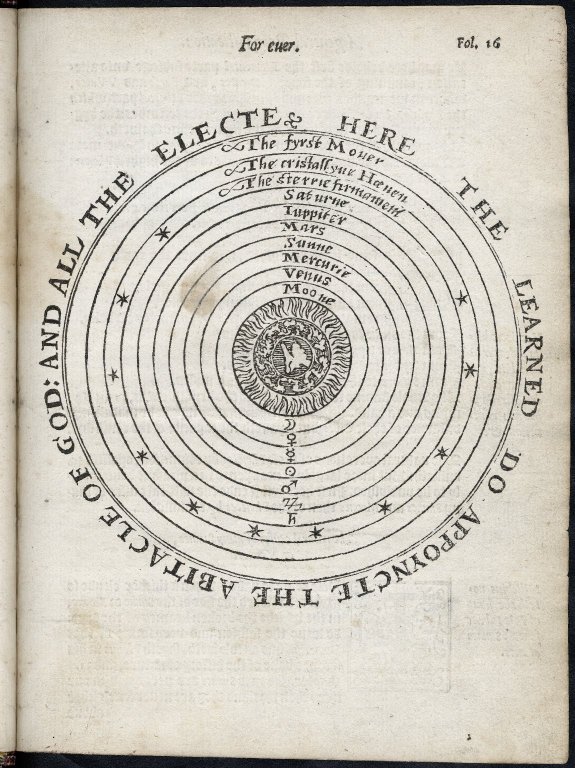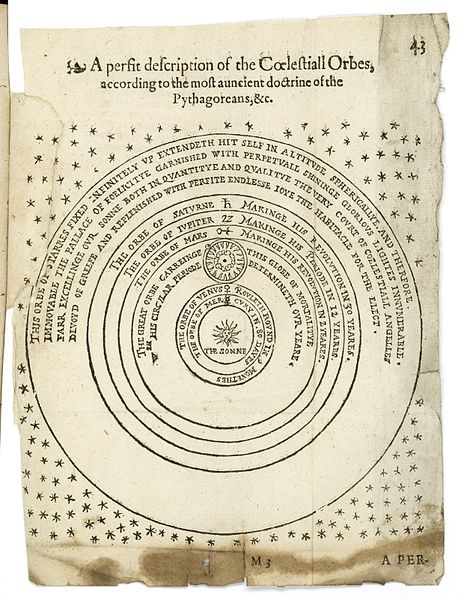Early Modern Astronomy
Scientific thinkers in the sixteenth and seventeenth centuries debated the planets’ position in our universe. Two competing models were the Ptolemaic or geocentric (the idea that the Earth was the center of the universe) and the Copernican or heliocentric (which imagined the sun at the center). The following texts and images are excerpted from an influential 1576 publication that brought together the two arguments in one book: the second edition of A Prognostication Everlasting by Leonard Digges, which included a translation of Nicholas Copernicus’s De Revolutionibus by Leonard’s son Thomas.
- The nature, course, color, and placing of these seven Planets, according to Ptolemy:
- Saturn is the highest and slowest: in proper motion, cold, dry and pale, like unto lead color requiring thirty years to end his course.
- Jupiter is the next under Saturn temperate, fair and mighty: his course is performed in 12 years.
- Mars is hot and dry of fiery color in two years endeth his course.
- The Sun is placed in the middle of all the Planets: most clear and bright, the well of pure light: every year finishing his course.
- Venus is next to the Sun cold, moist and clear, yea more brighter than Jupiter, her course is like unto the Sun’s: never above eight and forty degrees from the Sun, called [the] Morning Star when she goeth before the Sun, coming after the Sun, she is named the Even Star.
- Mercury is next under Venus, somewhat shining, but not very bright: never above 29 degrees from the Sun, his course, is like to Venus, or the Sun’s motion.
- The Moon is lowest of all the seven, running over [the] whole zodiac in 27 days and 8 hours and somewhat more.
This diagram of the universe, using a geocentric model, appears with Leonard Digges’s text.

A Prognostication euerlasting of ryght good effecte (London, 1556), fol. 16. By permission of the Folger Shakespeare Library.
A Perfect Description of the Celestial Orbs according to the most ancient doctrine of the Pythagoreans, lately revived by Copernicus and by Geometrical Demonstrations approved
Although in this most excellent and difficult part of Philosophy, in all times have been sundry opinions touching the situation and moving of the bodies Celestial, yet in certain principles all Philosophers of any account of all ages have agreed and consented. First, that the Orb of the fixed stars is of all other the most high, the farthest distant, and comprehendeth all the other spheres of wandering stars. And of these straying bodies called Planets the old philosophers thought it a good ground in reason that the nighest to the center should swiftliest move, because the circle was least and thereby the sooner overpassed, and the farther distant the more slowly. Therefore, as the Moon being swiftest in course is found also by measure nighest, so have all agreed that the Orb of Saturn, being in moving the slowest of all the Planets, is also the highest; Jupiter the next, and then Mars. But of Venus and Mercury there hath been great controversy, because they stray not every way from the Sun as the rest do. And therefore some have placed them above the Sun as Plato in his Timaeus, others beneath, as Ptolemy and the greater part of them that followed him. Alpetragius maketh Venus above the Sun and Mercury beneath, and sundry reasons have been of all sides alleged in defense of their opinions. They that follow Plato (supposing that all stars should have obscure & dark bodies shining with borrowed light like the Moon) have alleged that if those Planets were lower than the Sun, then should they sometime obscure some part of the body of the Sun, and also shine not with a light circular but segmentary, (and that variable as in the Moon) Which when they see by experience at no time to happen, they conclude with Plato. On the contrary part, such as will maintain them beneath, frame a likelihood by reason of the large space between the Orbs of Sun and Moon. [...] Again, the reason of Ptolemy that the Sun must needs be placed in the midst of those Planets that wander from him at liberty and those that are as it were combined to him, is proved senseless by the motion of the Moon, whom we see no less to stray from the Sun than any of those other three superior Planets. But if they will needs have these two Planets’ Orbs within an Orb of the Sun, what reason can they give why they should not depart from the Sun at large, as the other Planets do (considering the increase of swiftness in their motion must accompany the inferior situation, or else the whole order of Theoricks should be disturbed)? It is therefore evident that either there must be some other Center whereunto the order of these Orbs should be referred, or else no reason in their order, nor cause apparent, why we should rather to Saturn than to Jupiter, or any of the rest, attribute the higher or remoter Orb. And therefore seemeth it worthy of consideration that Martianus Capella wrote in his Encyclopedia, and certain other Latins held, affirming that Venus and Mercury do run about the Sun in their spheres peculiar, & therefore could not stray farther from the Sun than the capacity of their Orbs would give them leave, because they encompass not the Earth as the others do, but have their Apsides after another manner conversed, what other thing would they hereby signify but that the Orbs of these Planets should environ the Sun as their Center. So may the sphere of Mercury being not of half the amplitude of Venus’ Orb, be well situated within the same. And if in like sort we situate the Orbs of Saturn, Jupiter, and Mars, referring them as it were to the same Center, so as their capacity be such as they contain and circulate also the Earth, happily we shall not err, as by evident Demonstrations in the residue of Copernicus’ Revolutions is demonstrate. For it is apparent that these Planets, nigh the Sun are always least and farthest distant, and opposite are much greater in sight & nigher to us, whereby it cannot be but the center of them is rather to the Sun than to the earth to be referred, as in the Orbs of Venus and Mercury also. But, if all these to the Sun as a center in this manner be referred, then must there needs between the convex Orb of Venus and the concave of Mars an huge space be left, wherein the earth & Elementary frame enclosed with the Lunar Orb of duty must be situated. For, from the earth, the Moon may not be far removed, being without controversy of all other nighest in place and nature to it, especially considering between the same Orbs of Venus and Mars there is room sufficient. Therefore need we not to be ashamed to confess this whole globe of Elements enclosed with the Moon’s sphere, together with the earth as the Center of the same, to be by this great Orb together with the other Planets about the Sun turned, making by his revolution our year. And whatsoever seem to us to proceed by the moving of the Sun, the same to proceed in deed by the revolution of the earth, the Sun still remaining fixed & immoveable in the midst. And the distance of the earth from the Sun to be such, as being compared with the other Planets, maketh evident alterations and diversity of Aspects, but if it be referred to the Orb of stars fixed, then hath it no proportion sensible, but as a point or a Center to a circumference, which should far more reasonable to be granted, than to fall into such an infinite multitude of absurd imaginations, as they were fain to admit that will needs willfully maintain the earth's stability in the Center of the world. But rather herein to direct ourselves by that wisdom we see in all God’s natural works, where we may behold one thing rather endued with many virtues and effects, than any superfluous or unnecessary part admitted. And all these things, although they seem hard strange & incredible, yet to any reasonable man that hath his understanding ripened with Mathematical demonstration, Copernicus, in his Revolutions, according to his promise, hath made them more evident and clear than the Sun’s beams. These grounds therefore admitted, which no man reasonably can impugn–that the greater orb requireth the longer time to run his Period–the orderly and most beautiful frame of the Heavens doth ensue.
The first and highest of all is the immoveable sphere of fixed stars, containing itself and all the Rest, and therefore fixed as the place universal of Rest, whereunto the motions and positions of all inferior spheres are to be compared. For albeit sundry Astrologians finding alteration in the declination and Longitude of stars, have thought that the same also should have his motion peculiar: Yet Copernicus by the motions of the earth saveth all, and utterly cutteth off the ninth and tenth spheres, which, contrary to all sense, the maintainers of the earth’s stability have been compelled to imagine.
The first of the moveable Orbs is that of Saturn, which, being of all other next unto that infinite Orb immoveable garnished with lights innumerable, is also in his course most slow, & once only in thirty years passeth his Period.
The second is Jupiter, who in 12 years performeth his circuit.
Mars in 2 years runneth his circular race.
Then followeth the great Orb, wherein the globe of mortality, enclosed in the Moon’s Orb as an Epicycle, and holding the earth as a Center by his own weight resting always permanent, in the midst of the air is carried round once in a years.
In the fifth is Venus making her revolution in 9 months.
In the sixth is Mercury who passeth his circuit in 80 days.
In the midst of all is the Sun.
[...] And this may well be thought of us to be the glorious court of the great God, whose unsearchable works invisible, we partly by these his visible, conjecture; to whose infinite power and majesty, such an infinite place, surmounting all other both in quantity and quality, only is convenient.
This diagram of the universe, using a heliocentric model, appears with Thomas Digges’s “A Perfit Description of the Celestiall Orbs.”

A Prognostication euerlastinge of righte good effecte … Lately corrected and augmented by Thomas Digges (London, 1576). Wellcome Library, London.